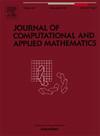拉普拉斯方程边界积分方程的高级方法:与基本解方法的关系
IF 2.6
2区 数学
Q1 MATHEMATICS, APPLIED
Journal of Computational and Applied Mathematics
Pub Date : 2025-10-03
DOI:10.1016/j.cam.2025.117135
引用次数: 0
摘要
考虑有界单连通域S中的拉普拉斯方程。S中的调和函数可以用第一类边界积分方程(BIE)表示,它定义在域边界Γ(=∂S)上。通过Γ上的源节点Q求解未知量,其离散算法称为常规边界积分方程法(BIEM)。从Sobolev可拓理论出发,可以用S∧SR将调和解扩展到更大的单连通域SR。我们通过将源节点Q从Γ移动到ΓR来更新BIEM,以消除BIEM的奇异性。它们的离散算法简单直接,称为离散边界积分方程法(DBIEM)。本文的主要工作是利用伽辽金方法对DBIEM进行误差分析。误差分析的一个重要应用是基本解方法(MFS),其中源节点Q也位于ΓR。Dou et al.(2020)、Li et al.(2009)、Li et al.(2023)中MFS的误差分析仅限于圆/椭圆伪边界。本文给出了非圆/非椭圆伪边界下MFS的误差分析。由于伪边界ΓR与传统边界元法中的边界Γ不同,因此其引理也与边界元法中的引理不同。第一项工作是证明新的自支撑引理。对于多边形域,在选择多边形伪边界时,与有限元法和边界元法一样,采用低阶分段插值多项式。导出了光滑解的误差界,以达到最优收敛速率。这种误差分析也适用于光滑Γ,常数/线性和线性/二次元可能会有广泛的应用。误差分析同样适用于MFS。数值实验证实了上述分析的正确性。本文对DBIEM和MFS的误差分析都是必不可少的。本文章由计算机程序翻译,如有差异,请以英文原文为准。
Advanced methods of boundary integral equations for Laplace’s equation: Relations to method of fundamental solutions
Consider Laplace’s equation in a bounded simply-connected domain . The harmonic functions in can be represented by boundary integral equations of the first kind (BIE), which is defined on the domain boundary . The unknowns are solved via the source nodes on , and their discrete algorithms are called the conventional boundary integral equation method (BIEM). From the Sobolev extension theory, the harmonic solutions can be extended to a larger simply-connected domain with . We renovate the BIEM by moving the source nodes from to , to eliminate the singularity of the BIEM. Their discrete algorithms are simple and straightforward, and called the discrete boundary integral equation method (DBIEM). The main effort of this paper is to explore the error analysis of the DBIEM via Galerkin approaches. An important application of the error analysis is for the method of fundamental solutions (MFS), where the source nodes are also located on . The error analysis of the MFS in Dou et al. (2020) , Li (2009), Li et al. (2023) is confined to circular/elliptic pseudo-boundaries. The error analysis of the MFS for non-circular/non-elliptic pseudo-boundaries can be obtained from this paper. Since the pseudo-boundary is different from the boundary in the conventional BIEM, the inf-sup lemma is different from that in the boundary element method (BEM). The first work is to prove the new inf-sup lemma. For polygonal domains, when polygonal pseudo-boundaries are chosen, the piecewise interpolation polynomials of low orders are used as in the finite element method (FEM) and the BEM. The error bounds are derived for smooth solutions to achieve the optimal convergence rates. This error analysis is also valid for smooth , and the constant/linear and linear/quadratic elements may find wide applications. The error analysis can also be applied to the MFS. Numerical experiments are reported to verify the analysis made. This paper is essential to the error analysis of both the DBIEM and the MFS.
求助全文
通过发布文献求助,成功后即可免费获取论文全文。
去求助
来源期刊
CiteScore
5.40
自引率
4.20%
发文量
437
审稿时长
3.0 months
期刊介绍:
The Journal of Computational and Applied Mathematics publishes original papers of high scientific value in all areas of computational and applied mathematics. The main interest of the Journal is in papers that describe and analyze new computational techniques for solving scientific or engineering problems. Also the improved analysis, including the effectiveness and applicability, of existing methods and algorithms is of importance. The computational efficiency (e.g. the convergence, stability, accuracy, ...) should be proved and illustrated by nontrivial numerical examples. Papers describing only variants of existing methods, without adding significant new computational properties are not of interest.
The audience consists of: applied mathematicians, numerical analysts, computational scientists and engineers.

 求助内容:
求助内容: 应助结果提醒方式:
应助结果提醒方式:


